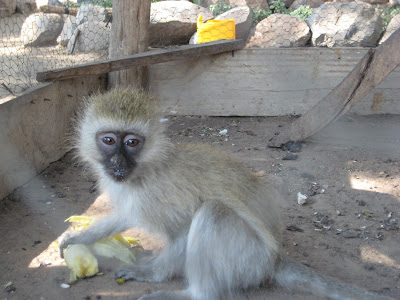After the demonstration, we ventured nearer the park, to a more remote farm that had had huge problems with elephant damage to the crops. Interestingly, women were in control of the local village government for the area this farm was in, and they welcomed us and introduced us to a farmer who had adopted some of the elephant control measures successfully. He was really proud of how he was able to keep the elephants off his land, and his farm was much more prosperous than it had been before he set up these controls. We got a little sidetracked at the farm talking with Khun Bala talking about how villagers managed water in Myanmar, but it was good to see him participating and excited about this part of the course.
 Mzee Msago, from the WCS Ruaha Landscape Program, and the women who were the village leaders, talking about elephant crop damage
Mzee Msago, from the WCS Ruaha Landscape Program, and the women who were the village leaders, talking about elephant crop damageWhen we got back to camp, Alphonse led a small group of us to the campsite down the road that had a "snake park." The owner of the campsite and snake park showed us around his collection of snakes, turtles, and two vervet monkeys. He had about ten snakes, all local species in the area, and all nice and dangerous.
To celebrate our last night at Chogela, they threw a party for us and invited the Tungamalenga WaHehe (Wa, meaning "people," Hehe, pronounced hay-hay, being the name of the tribe) traditional dance troupe. A Maasai man cooked all the parts of the goat on the campfire as we sat around the fire in the growing darkness. The Hehe dancers came out, faces painted white, and drummed and sang while dancing around the fire. We were invited to join in, and by the end everyone in the group was up, circling the fire in an approximation of the walk-dance step of the Hehe dance. It was pretty funny to see some of the group dancing--normally shy and quiet Denis breaking it down with a huge grin on his face, and our fearless leader Val wiggling along in time to the drums.
After the WaHehe left, we were inspired to start doing other dances that the Americans knew, and teaching them to some of the international students. Seeing Julius, Fidy, and Alphonse learn the electric slide and the macarena was pretty priceless. We discovered that it was Deanna's birthday the next day, and with a stroke of genius--motivated mostly by Jonna Mazet's daughters--decided we'd put on a dance performance for her the next day. We came up with an elaborate routine consisting of square dance, electric slide, macarena, and the chicken dance, with the boys in the back row singing and dancing along to the YMCA song. It was impressive, to say the least.





No comments:
Post a Comment